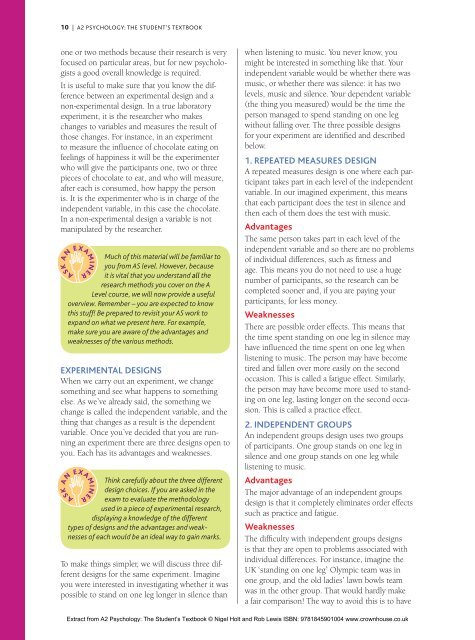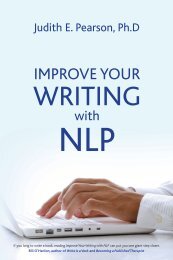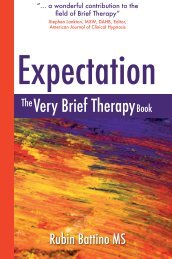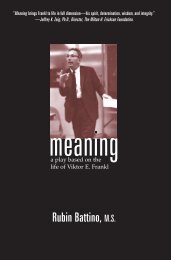Nigel Holt and Rob Lewis - Crown House Publishing.
Nigel Holt and Rob Lewis - Crown House Publishing.
Nigel Holt and Rob Lewis - Crown House Publishing.
You also want an ePaper? Increase the reach of your titles
YUMPU automatically turns print PDFs into web optimized ePapers that Google loves.
10 | A2 PSYCHOLOGY: THE STUDENT’S TEXTBOOKone or two methods because their research is veryfocused on particular areas, but for new psychologistsa good overall knowledge is required.It is useful to make sure that you know the differencebetween an experimental design <strong>and</strong> anon-experimental design. In a true laboratoryexperiment, it is the researcher who makeschanges to variables <strong>and</strong> measures the result ofthose changes. For instance, in an experimentto measure the influence of chocolate eating onfeelings of happiness it will be the experimenterwho will give the participants one, two or threepieces of chocolate to eat, <strong>and</strong> who will measure,after each is consumed, how happy the personis. It is the experimenter who is in charge of theindependent variable, in this case the chocolate.In a non-experimental design a variable is notmanipulated by the researcher.Much of this material will be familiar toyou from AS level. However, becauseit is vital that you underst<strong>and</strong> all theresearch methods you cover on the ALevel course, we will now provide a usefuloverview. Remember – you are expected to knowthis stuff! Be prepared to revisit your AS work toexp<strong>and</strong> on what we present here. For example,make sure you are aware of the advantages <strong>and</strong>weaknesses of the various methods.Experimental designsWhen we carry out an experiment, we changesomething <strong>and</strong> see what happens to somethingelse. As we’ve already said, the something wechange is called the independent variable, <strong>and</strong> thething that changes as a result is the dependentvariable. Once you’ve decided that you are runningan experiment there are three designs open toyou. Each has its advantages <strong>and</strong> weaknesses.Think carefully about the three differentdesign choices. If you are asked in theexam to evaluate the methodologyused in a piece of experimental research,displaying a knowledge of the differenttypes of designs <strong>and</strong> the advantages <strong>and</strong> weaknessesof each would be an ideal way to gain marks.To make things simpler, we will discuss three differentdesigns for the same experiment. Imagineyou were interested in investigating whether it waspossible to st<strong>and</strong> on one leg longer in silence thanwhen listening to music. You never know, youmight be interested in something like that. Yourindependent variable would be whether there wasmusic, or whether there was silence: it has twolevels, music <strong>and</strong> silence. Your dependent variable(the thing you measured) would be the time theperson managed to spend st<strong>and</strong>ing on one legwithout falling over. The three possible designsfor your experiment are identified <strong>and</strong> describedbelow.1. Repeated measures designA repeated measures design is one where each participanttakes part in each level of the independentvariable. In our imagined experiment, this meansthat each participant does the test in silence <strong>and</strong>then each of them does the test with music.AdvantagesThe same person takes part in each level of theindependent variable <strong>and</strong> so there are no problemsof individual differences, such as fitness <strong>and</strong>age. This means you do not need to use a hugenumber of participants, so the research can becompleted sooner <strong>and</strong>, if you are paying yourparticipants, for less money.WeaknessesThere are possible order effects. This means thatthe time spent st<strong>and</strong>ing on one leg in silence mayhave influenced the time spent on one leg whenlistening to music. The person may have becometired <strong>and</strong> fallen over more easily on the secondoccasion. This is called a fatigue effect. Similarly,the person may have become more used to st<strong>and</strong>ingon one leg, lasting longer on the second occasion.This is called a practice effect.2. Independent groupsAn independent groups design uses two groupsof participants. One group st<strong>and</strong>s on one leg insilence <strong>and</strong> one group st<strong>and</strong>s on one leg whilelistening to music.AdvantagesThe major advantage of an independent groupsdesign is that it completely eliminates order effectssuch as practice <strong>and</strong> fatigue.WeaknessesThe difficulty with independent groups designsis that they are open to problems associated withindividual differences. For instance, imagine theUK ‘st<strong>and</strong>ing on one leg’ Olympic team was inone group, <strong>and</strong> the old ladies’ lawn bowls teamwas in the other group. That would hardly makea fair comparison! The way to avoid this is to haveExtract from A2 Psychology: The Student’s Textbook © <strong>Nigel</strong> <strong>Holt</strong> <strong>and</strong> <strong>Rob</strong> <strong>Lewis</strong> ISBN: 9781845901004 www.crownhouse.co.uk

















